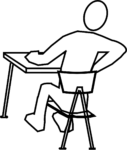
NICE updating 2009 guidelines for back pain management
 A draft guideline from NICE on the management of back pain has been published for public consultation. The draft is updated guidance published in 2009 and recommends exercise, in all its forms, from stretching to strengthening, aerobic and yoga, as the first step to managing low back pain.
A draft guideline from NICE on the management of back pain has been published for public consultation. The draft is updated guidance published in 2009 and recommends exercise, in all its forms, from stretching to strengthening, aerobic and yoga, as the first step to managing low back pain.
It also says that massage and manipulation by a therapist should only be used alongside exercise because there is not enough evidence to show that they are beneficial when used alone.
While the draft guidelines recommend encouraging people to continue with their normal activities where possible, it no longer recommends acupuncture for the treatment of low back pain because evidence shows it is not better than a sham and that paracetamol on its own in no longer the first option for managing low back pain, with non-steroidal anti-inflammatory drugs (NSAIDs) such as ibuprofen or aspirin recommended to be tried first. Weak opioids, such as codeine, are now only recommended for acute back pain when NSAIDs haven’t worked or aren’t suitable.
Other recommendations including talking therapies to be tried in combination with physical treatments for people who have not seen an improvement in their pain on previous treatments.
The updated draft guideline has been expanded to include people with sciatica, a painful condition typically caused by irritation or compression of the nerves which run from the lower back, through the legs and down to the feet.
Unlike the previous guideline, which only covered the management of low back pain that had lasted between 6 weeks and 12 months, the updated guideline covers people with low back pain or sciatica irrespective of how long they have had the condition
Professor Mark Baker, clinical practice director for NICE, says, “Millions of people are affected every year by these often debilitating and distressing conditions. For most their symptoms improve in days or weeks. However for some, the pain can be distressing and persist for a long time.
“Regrettably there is a lack of convincing evidence of effectiveness for some widely used treatments. For example acupuncture is no longer recommended for managing low back pain with or without sciatica. This is because there is not enough evidence to show that it is more effective than sham treatment.”
The final guideline is due to be published in September 2016.
For more in-depth features, interviews and information, subscribe to Arthritis Digest magazine, a popular title that’s published six times a year. Click here for the digital version or tel 0845 643 8470 to order your had copy. You’ll know what your doctor is talking about, what new drugs are in the pipeline and be up to date on helpful products.
